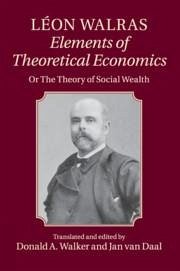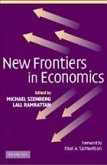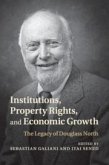- Broschiertes Buch
- Merkliste
- Auf die Merkliste
- Bewerten Bewerten
- Teilen
- Produkt teilen
- Produkterinnerung
- Produkterinnerung
The third edition (1896) of Leon Walras' Elements of Theoretical Economics has been given a new translation for three reasons. First, this edition is Walras' best theoretical work. Second, the two subsequent editions contain new elements that spoil his previous work. Third, William Jaffe's translation (1954) of the last edition is now outdated in view of recent research on Walras' ideas.
Andere Kunden interessierten sich auch für
![William Jaffe's Essays on Walras William Jaffe's Essays on Walras]() Donald A. Walker (ed.)William Jaffe's Essays on Walras49,99 €
Donald A. Walker (ed.)William Jaffe's Essays on Walras49,99 €![Innovation and the Evolution of Industries Innovation and the Evolution of Industries]() Franco MalerbaInnovation and the Evolution of Industries41,99 €
Franco MalerbaInnovation and the Evolution of Industries41,99 €![New Frontiers in Economics New Frontiers in Economics]() Michael Szenberg / Lall Ramrattan (eds.)New Frontiers in Economics36,99 €
Michael Szenberg / Lall Ramrattan (eds.)New Frontiers in Economics36,99 €![The Political Economy of Public Finance The Political Economy of Public Finance]() The Political Economy of Public Finance41,99 €
The Political Economy of Public Finance41,99 €![Advances in Economics and Econometrics Advances in Economics and Econometrics]() Richard Blundell / Whitney K. Newey / Torsten Persson (eds.)Advances in Economics and Econometrics49,99 €
Richard Blundell / Whitney K. Newey / Torsten Persson (eds.)Advances in Economics and Econometrics49,99 €![Institutions, Property Rights, and Economic Growth Institutions, Property Rights, and Economic Growth]() Institutions, Property Rights, and Economic Growth41,99 €
Institutions, Property Rights, and Economic Growth41,99 €![The Rise and Decline of the Free Trade Movement The Rise and Decline of the Free Trade Movement]() William CunninghamThe Rise and Decline of the Free Trade Movement39,99 €
William CunninghamThe Rise and Decline of the Free Trade Movement39,99 €-
-
-
The third edition (1896) of Leon Walras' Elements of Theoretical Economics has been given a new translation for three reasons. First, this edition is Walras' best theoretical work. Second, the two subsequent editions contain new elements that spoil his previous work. Third, William Jaffe's translation (1954) of the last edition is now outdated in view of recent research on Walras' ideas.
Produktdetails
- Produktdetails
- Verlag: Cambridge University Press
- Seitenzahl: 589
- Erscheinungstermin: 16. Mai 2019
- Englisch
- Abmessung: 227mm x 153mm x 32mm
- Gewicht: 796g
- ISBN-13: 9781107651456
- ISBN-10: 110765145X
- Artikelnr.: 56713629
- Herstellerkennzeichnung
- Libri GmbH
- Europaallee 1
- 36244 Bad Hersfeld
- gpsr@libri.de
- Verlag: Cambridge University Press
- Seitenzahl: 589
- Erscheinungstermin: 16. Mai 2019
- Englisch
- Abmessung: 227mm x 153mm x 32mm
- Gewicht: 796g
- ISBN-13: 9781107651456
- ISBN-10: 110765145X
- Artikelnr.: 56713629
- Herstellerkennzeichnung
- Libri GmbH
- Europaallee 1
- 36244 Bad Hersfeld
- gpsr@libri.de
Translators' introduction
Part I. Objects and Divisions of Economics: 1. Adam Smith's and J.-B. Say's definitions
2. Distinction between science, the arts, and ethics
3. Social wealth
4. The fact of industry and applied economics
Part II. Theory of Exchange: 5. The market and competition
6. Curves of effective demand and effective supply
7. Discussion of the solution of the problem of the exchange of two commodities for each other
8. Utility or want curves
9. Discussion of demand curves
10. Rareté, or the cause of value in exchange
11. The problem of the exchange of several commodities for one another
12 General formula of the mathematical solution of the problem of the exchange of several commodities for one another
13. Law of the variation of the prices of the commodities
14. Theorem of equivalent redistributions
15. Purchase curves and sales curves
16. Exposition and refutation of Adam Smith's and J.-B. Say's doctrines of the origin of value in exchange
Part III. Theory of Production: 17. Capital and income
18. Elements and mechanism of production
19. The entrepreneur
20. Equations of production
21. Solution of the equations of production
22. The principle of free competition
Part IV. Theory of Capital Formation and Credit: 23. Gross and net income
24. Equations of capital formation and credit
25. Solution of the equations of capital formation and credit
26. Theorem of the maximum utility of new capital goods
27. Laws of the determination and variation of the prices of capital goods
28. Increase of the quantity of products
29. Critique of the physiocratic doctrine
30. Exposition and refutation of the English theory of the price of products
31. Exposition and refutation of the English theory of rent
32. Exposition and refutation of the English theories of wages and interest
Part V. Theory of Money: 33. The problem of the value of money
34. Mathematical theory of bimetallism
35. Relative stability of the value of the bimetallic standard
36. Fiduciary money and offsetting claims
Part VI. Price Fixing, Monopoly, and Taxation: 37. Price fixing and monopoly
38. Taxation.
Part I. Objects and Divisions of Economics: 1. Adam Smith's and J.-B. Say's definitions
2. Distinction between science, the arts, and ethics
3. Social wealth
4. The fact of industry and applied economics
Part II. Theory of Exchange: 5. The market and competition
6. Curves of effective demand and effective supply
7. Discussion of the solution of the problem of the exchange of two commodities for each other
8. Utility or want curves
9. Discussion of demand curves
10. Rareté, or the cause of value in exchange
11. The problem of the exchange of several commodities for one another
12 General formula of the mathematical solution of the problem of the exchange of several commodities for one another
13. Law of the variation of the prices of the commodities
14. Theorem of equivalent redistributions
15. Purchase curves and sales curves
16. Exposition and refutation of Adam Smith's and J.-B. Say's doctrines of the origin of value in exchange
Part III. Theory of Production: 17. Capital and income
18. Elements and mechanism of production
19. The entrepreneur
20. Equations of production
21. Solution of the equations of production
22. The principle of free competition
Part IV. Theory of Capital Formation and Credit: 23. Gross and net income
24. Equations of capital formation and credit
25. Solution of the equations of capital formation and credit
26. Theorem of the maximum utility of new capital goods
27. Laws of the determination and variation of the prices of capital goods
28. Increase of the quantity of products
29. Critique of the physiocratic doctrine
30. Exposition and refutation of the English theory of the price of products
31. Exposition and refutation of the English theory of rent
32. Exposition and refutation of the English theories of wages and interest
Part V. Theory of Money: 33. The problem of the value of money
34. Mathematical theory of bimetallism
35. Relative stability of the value of the bimetallic standard
36. Fiduciary money and offsetting claims
Part VI. Price Fixing, Monopoly, and Taxation: 37. Price fixing and monopoly
38. Taxation.
Translators' introduction
Part I. Objects and Divisions of Economics: 1. Adam Smith's and J.-B. Say's definitions
2. Distinction between science, the arts, and ethics
3. Social wealth
4. The fact of industry and applied economics
Part II. Theory of Exchange: 5. The market and competition
6. Curves of effective demand and effective supply
7. Discussion of the solution of the problem of the exchange of two commodities for each other
8. Utility or want curves
9. Discussion of demand curves
10. Rareté, or the cause of value in exchange
11. The problem of the exchange of several commodities for one another
12 General formula of the mathematical solution of the problem of the exchange of several commodities for one another
13. Law of the variation of the prices of the commodities
14. Theorem of equivalent redistributions
15. Purchase curves and sales curves
16. Exposition and refutation of Adam Smith's and J.-B. Say's doctrines of the origin of value in exchange
Part III. Theory of Production: 17. Capital and income
18. Elements and mechanism of production
19. The entrepreneur
20. Equations of production
21. Solution of the equations of production
22. The principle of free competition
Part IV. Theory of Capital Formation and Credit: 23. Gross and net income
24. Equations of capital formation and credit
25. Solution of the equations of capital formation and credit
26. Theorem of the maximum utility of new capital goods
27. Laws of the determination and variation of the prices of capital goods
28. Increase of the quantity of products
29. Critique of the physiocratic doctrine
30. Exposition and refutation of the English theory of the price of products
31. Exposition and refutation of the English theory of rent
32. Exposition and refutation of the English theories of wages and interest
Part V. Theory of Money: 33. The problem of the value of money
34. Mathematical theory of bimetallism
35. Relative stability of the value of the bimetallic standard
36. Fiduciary money and offsetting claims
Part VI. Price Fixing, Monopoly, and Taxation: 37. Price fixing and monopoly
38. Taxation.
Part I. Objects and Divisions of Economics: 1. Adam Smith's and J.-B. Say's definitions
2. Distinction between science, the arts, and ethics
3. Social wealth
4. The fact of industry and applied economics
Part II. Theory of Exchange: 5. The market and competition
6. Curves of effective demand and effective supply
7. Discussion of the solution of the problem of the exchange of two commodities for each other
8. Utility or want curves
9. Discussion of demand curves
10. Rareté, or the cause of value in exchange
11. The problem of the exchange of several commodities for one another
12 General formula of the mathematical solution of the problem of the exchange of several commodities for one another
13. Law of the variation of the prices of the commodities
14. Theorem of equivalent redistributions
15. Purchase curves and sales curves
16. Exposition and refutation of Adam Smith's and J.-B. Say's doctrines of the origin of value in exchange
Part III. Theory of Production: 17. Capital and income
18. Elements and mechanism of production
19. The entrepreneur
20. Equations of production
21. Solution of the equations of production
22. The principle of free competition
Part IV. Theory of Capital Formation and Credit: 23. Gross and net income
24. Equations of capital formation and credit
25. Solution of the equations of capital formation and credit
26. Theorem of the maximum utility of new capital goods
27. Laws of the determination and variation of the prices of capital goods
28. Increase of the quantity of products
29. Critique of the physiocratic doctrine
30. Exposition and refutation of the English theory of the price of products
31. Exposition and refutation of the English theory of rent
32. Exposition and refutation of the English theories of wages and interest
Part V. Theory of Money: 33. The problem of the value of money
34. Mathematical theory of bimetallism
35. Relative stability of the value of the bimetallic standard
36. Fiduciary money and offsetting claims
Part VI. Price Fixing, Monopoly, and Taxation: 37. Price fixing and monopoly
38. Taxation.









